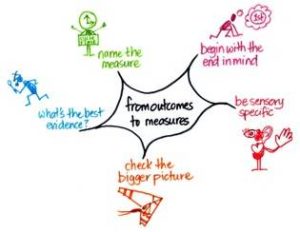
How to find the right measures is the most asked question in the field of performance measurement. And it’s little wonder, because the more meaningful measures track outcomes which tend to be less tangible than the traditional things we’ve measured, like how many widgets we produced.
How do you translate results so intangible as employee morale or service quality or corporate image into solid, robust measures?
The framework described here is an excerpt of the PuMP methodology, which provides a systematic approach for taking almost all of the pain out of the challenge of finding the right measures.
STEP 1: Begin with the end in mind.
Performance measures are objective comparisons that provide evidence of an important performance outcome. It is of the utmost importance to decide which outcomes are most worth tracking right now. As the first step in deciding how to measure an outcome, write down what the outcome is, what the difference is you are trying to create (and thus want to track using a measure). Focus on one outcome at a time.
STEP 2: Be sensory specific.
When you have the end in mind, you are ready to get a handle on what specifically about your outcome you will measure. This is where you take care in your choice of words to describe the outcome as concretely as possible. Use “sensory” language – the language that describes what you and others would see, hear, feel, do, taste or smell if your outcome was happening now. Avoid those inert words that we so often see in our goal and objective statements, such as: efficient, effective, reliable, sustainable and quality.
STEP 3: Check the bigger picture.
Check the bigger picture for what could happen if you measure your outcome. What level of control do you have over achieving it? What might the unintended consequences of measuring the outcome be (both the positive and the negative)? What behaviour would the measures drive? Which other areas of performance might be sabotaged or limited? This is your first chance to change your mind about what’s most worth measuring.
STEP 4: What’s the evidence?
Now, get ultra specific and figure out what the potential measures are that could let you (and everyone else) know that the outcome is being achieved. For each of your sensory rich statements from step 2, what could you count to tell you the extent to which it is occurring? Which of these potential measures would be the optimal balance between objectivity and feasibility?
STEP 5: Name the measure.
Naming your performance measures marks the point at which you know exactly what you will be measuring. Be succinct and informative and deliberate, as you need to be able to continually and easily identify each measure as it moves through the steps of being brought to life and being used in decision making.
|
Stacey Barr Performance Measure Specialist Stacey Barr is a specialist in organizational performance measurement and creator of PuMP, the refreshingly practical, step-by-step performance measurement methodology designed to overcome people’s biggest struggles with KPIs and measures. |

